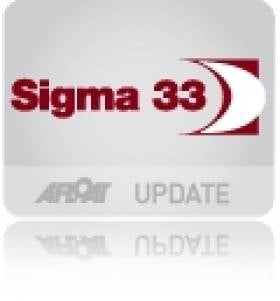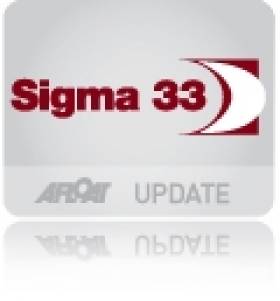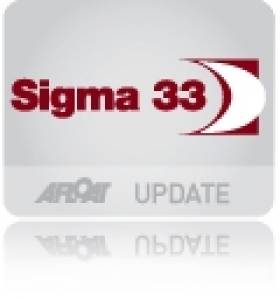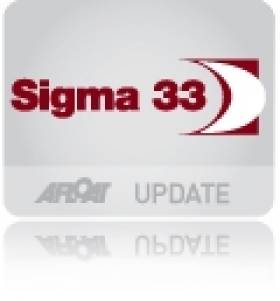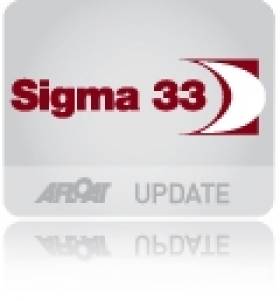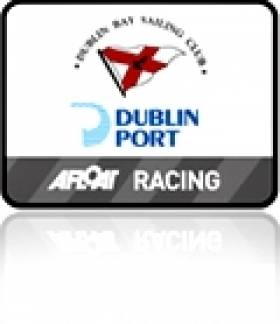Displaying items by tag: Sigma 33
Successful Irish Sigma 33 'White Mischief' Goes on Sale at €27,500
The successful Sigma 33 White Mischief, based in Dun Laoghaire, has gone on sale through yacht broker Leinster Boats.
Built by Marine Projects, the Sigma 33 has proved to be a popular club and regatta one design well capable of making distant passages to regattas and events. This Sigma 33 is one of the last to be built and has been wintered ashore annually and is, according to the broker, 'the best example'.
The Sigma has proven to be a safe family cruiser with the option of class racing in Irish and UK waters. White Micshief's owner and Afloat's Sailor of the Month for November 2015 has moved on to a new sailing project.
Check out the full advert for the yacht here
Sigma 33 Star Tim Goodbody Honoured at Royal Irish Prizegiving
Multiple champion Tim Goodbody's retirement from the Sigma 33 class was saluted at a packed Royal Irish Yacht Club on Friday night when class captain Paddy Maguire honoured the stalwart with an 'Excellence Award' setting out his achievements over 16 years in the one design keelboat class.
In 1999, Goodbody bought his Sigma 33 White Mischief. He was joined by two of his crew that had sailed with him previously, namely Paul McCarthy and Brendan Farrell and was joined by Patrick Cafferky, Paddy Boyd, David Crawford and Richard Cotton to form the basis of the new crew.
From 1999 to the current season they won the UK National Championships, the Irish Championships and all of the club prizes in Dublin Bay Sailing Club (DBSC). They also achieved podium finishes in many other events. Of all races that Tim and the White Mischief crew competed in, Maguire estimated they won '75% of all races sailed; an extraordinary achievement'.
'This performance record clearly demonstrates an exception level of ability and sailing skills that are so rarely if ever achieved in a One Design Class. More importantly it was achieved on a consistent basis throughout', Maguire told the class.
It is the second honour for Goodbody in as many weeks. Last weekend DBSC honoured the Dun Laoghaire sailor at its prizegiving when it uniquely captured Goodbody, his son and grandchildren all as annual prizewinners in Ireland's biggest sailing league.
86 members were in attendance for the prizegiving including no less than five Commodores and the Chairman of Sigma 33 Class Paul Prentice.
The prizes were awarded to :
White Mischief : Tim Goodbody : Sigma Model : Best of Sigma qualities
Leeuwin: Henry Leonard & Bobby Kerr : Corinthian Qualities
Rupert: Dick & Philip Lovegrove : September Series Winner
Sigma 33 Sailing Cruiser For Sale at €18,000
This Sigma 33 can be viewed in Dun Laoghaire where she will be lifted for winter storage. Popje is an "in class" Sigma that will make comfortable passage and provide good racing. More details here
#dlregatta – The Sigma 33 class has announced its Irish National Championships 2015 will be held in conjunction with Volvo Dun Laoghaire Regatta from 9th to 12th July 2015. The regatta is likely to be the biggest Sigma Class event of 2015, accordiong to class captain Paddy Maguire. 'To date there is a very strong entry of seven visiting crews which with the local fleet brings the total entry so far to 16', he told Afloat.ie. This – to date – is the biggest entry of one design cruisers for the 400–boat biennial regatta.
#sigma33 – The Sigma 33 Class on Dublin Bay will race in Cruisers 2 for the first time in 15 years it has been confirmed by Sigma 33 class captain Paddy Maguire.
The Sigma's will receive results in 2015 as one design, IRC and echo which will add a variety to their racing and prove a great challenge for both Sigmas and Cruisers 2 alike.
In November 2014 the Class proposed to DBSC that the Sigma 33 would race in Cruisers 2 for 2015 and this was accepted by DBSC. The reason for the change was to provide a more enjoyable and completive racing by sailing ng against more boats in a bigger fleet. The new Cruisers 2 fleet for 2015 will be one of the biggest keel boat fleets in Dun Laoghaire with approximately 25 Boats.
To compete in 2015 in the Cruisers 2 the Sigma's will have to improve their performance on the water. To this end they have developed a very attractive sailing programme for the season including a Coastal race, Ladies race and a ballet race to name but a few. The new programme of events will be launched this Friday 6th March at the National Yacht Club with a Sailing supper and talk by Prof O'Connell "HOW TO IMPROVE YOUR RESULTS BY 20% in 2015" to a full house.
One of the other big challenges is to increase the number of crew both male and female as part of the process of improving the individual boat performance.
Anyone interested in sailing can obtain the contacts details on the website here
Donald McClaren sailing Sigmatic won the UK Sigma 33 British Championships on the home waters of the Northern Clyde at the weekend (June 21-23) with Dublin Bay's Tim Goodbody fourth overall in the 18–boat fleet at Helensburgh, Scotland.
Ten races were sailed according to the latest (and poorly presented) results on the Helensburgh Sailing Club website here
Three local Bangor boats, joined 15 others from all over the United Kingdom and Ireland for the Sigma 33 OOD Class Championships in Helensburgh, Scotland from 21-23 June. The boats and crews were treated to incredibly tight racing in the full range of Scottish summer weather; flat calms and scorching sun to driving rain and screaming winds! All spliced together with a warm and sociable welcome from Helensburgh Sailing Club and the Sigma fleet. The members of both former and latter enjoying much discussion of the new trial sails, with both results and conjecture indicating it's the crews not the sails that make the difference.
Despite the changeable weather, all ten races were completed and following the successes of the Royal Ulster/ Ballyholme fleet at the Irish Championships all three crews put in strong performances. Sula (D&E Taylor and crew), showed fantastic speed through out the event but suffered at the hands of some unfortunate start line incidents. Despite this they fought back to record multiple top 5 results and win the Silver fleet. Cariad (G Bell and crew), showed why they are never far off the pace at any event and at times were resurgent right at the front of the fleet fighting it out for line honours finishing a credible 7th overall. They were beaten only by local boats savvy to the complex tides of the race area, ten times Irish Champions White Mischief (T Goodbody and crew) from Dublin and newly crowned Irish Champions for 2013, Squawk (P&E Prentice and crew.) Squawk had a consistent regatta collecting multiple top 3 results, including two race wins. Leading by one point going into the last race fell at the final hurdle to finish 3rd Overall, drawn down the fleet by a single result in double figures.
The reigning Class Champion Sigmatic (D Mclaren and crew) won the event with as much flare and passion as they put into organising it. Whilst another boat local to Helensburgh, Close Encounters (G Whyte and crew) sailed a phenomenally consistent event to finish second just two point adrift.
1st Sigmatic (D McClaren and crew), 2nd Close Encounters (G Whyte and crew), 3rd Squawk (P Prentice and crew), 4th White Mischief (T Goodbody and crew), 5th Leaky Roof II (A Harper and crew). The class looks forward to joining South Caernarvonshire Yacht Club, Abersoch in June 2014 for the next class championship.
A fortnight ago, Dublin Bay's only entrant in the Royal Ulster YC hosted Irish Sigma 33 Championships in Bangor from 7th–9th June 2013 was past champion, Goodbody.
The White Mischief crew from the Royal Irish YC crew were fourth from a disappointing turnout of eight boats for the ten race series.
The Irish championships was won by Royal Ulster's Squawk sailed by Paul Prentice and followed by Elaine and David Taylor's Sula. Third was Signet of Kip (P Martin) from Strangford.
Full results here
Scottish Raiders Take Sigma 33 Title on Dublin Bay
#sigma33 – Not even a judge from the 'Dragon's Den' TV show could stop a Scottish crew from claiming the class Sigma 33 title on Dublin Bay at the weekend. SCROLL DOWN FOR FULL RESULTS SHEETS AND PHOTOS BELOW.
Sailed in a range of both heavy and light conditions defending champion (and the championship host) Tim Goodbody of the Royal Irish Yacht Club lost his title but finished top Dublin Bay boat in third place as Clyde visitor Donald McLaren's Sigma 33 'Sigmatic' emerged as the clear winner.
Fifty knot gusts cancelled Friday's opening two races but Race officer Brian Mathews completed the schedule by setting four races still in blustery conditions on Saturday. A further three races were held yesterday.
Regular Sigma 33 sailor Bobby Kerr, a judge on the TV Business show Dragon's Den, was one of 24 boats competing in what was the biggest Sigma 33 event for a decade.
'Leaky Roof', Alan Harper also from the Clyde was second.
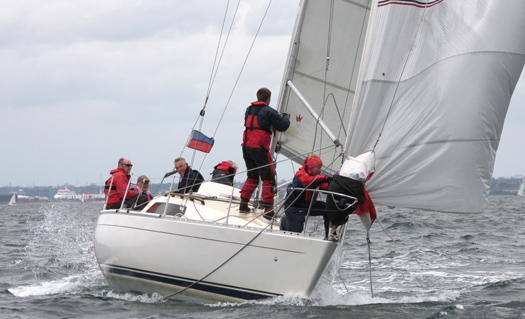
The overall winner Sigmatic
Goodbody's White Mischief also won the Irish Sigma Championships with Sula from Bangor in second place.
Sunday dawned a lovely clear day with steady westerly winds of 15 knots gusting 20 making a difficult choice as the whether a No 1 or No 2 was the correct headsail choice with the fleet evenly divided.
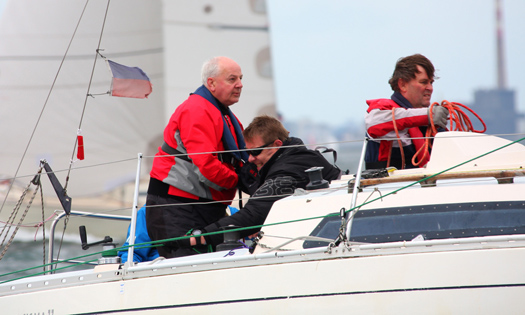
TV's Dragon's Den and Sigma sailor Bobby Kerr in action at the Sigma 33 Nationals on Dublin Bay. Photo: Afloat.ie
Race Officer Jack Roy set perfect starting lines of the correct length with a first windward leg of 1.3 miles and so the faster yachts had time to benefit from any speed advantage and they came to the front consistently. Most results came down to establishing an overlap at the last leeward mark with the top 5 or 6 boats crossing the finishing line closely packed followed by the rest of the fleet competing for their places.
The "Silver" fleet was won by Dick Lovegrove's Rupert with Dermot Clarke and Paddy Maguire's Gwilli Two in second place.
This was a competitive weekend's racing in Dublin Bay and the willingness of competitors to take penalty turns demonstrated a knowledge of the rules and desire to abide by them. This all added to achieving a competitive and friendly regatta which was enjoyed by all.
A gallery of photos from Saturday afternoon's Sigma action is below
#sigma33 – The Sigma 33 class has attracted the highest entry for over a decade for it's national championships on Dublin Bay at the weekend with competitors arriving from across the Irish sea from Scotland, Belfast Lough, Strangford Lough, Liverpool, Abersoch, Plymouth, Kinsale as well as a strong local DBSC contingent.
(Post regatta results, report and photos here)
The Royal Irish Yacht Club (RIYC) is hosting the 20-boat event from Friday through to Sunday.
This strong entry underlines the popularity of this seaworthy One Design offshore racing yacht which enjoys strong one design racing in so many centres as well as being very competitive under IRC.
The Championship offers competitors a choice of windward leeward, Olympic type and "round the cans" courses in Dublin Bay under the expert guidance of Principal Race Officer Jack Roy who will be setting courses at the Olympic Games in Weymouth next month.
The defending Class and Irish Champion is Tim Goodbody's White Mischief and they can expect strong competition from previous Champions such as Sigmatic from the Clyde as well as from many other visiting and local yachts including the Bay's own Gwilli Two skippered by Paddy Maguire.
ISORA Entry List 2011
Up to 40 yachts form the backbone of the Irish Sea Offshore Racing Association fleet (ISORA). Although the 2011 entry list (below) shows a large number of Beneteau models it also reveals a wide range of other marques, largely between 30 and 50 foot. Prominent types are J109s, Sigma 33s and a number of Jeanneau yachts too.
ISORA 2011 Racing Fleet
| Boat Name | Sail no | Hull / Mast Col | Model |
| Lancastrian | GBR7682T | White | Starlight |
| Yahtzee | IRL 1068 | White/Gold | Oceanis 41 |
| Rebellion | IRL 6001 | Blue/Silver | Nicholson 58 |
| Miss Scarlett | IRL 4763 | White/Gray | Sunfast 40.3 |
| Orna | IRL532 | Blue | 40C |
| Mistral of St Helier | K8337 | White | 3800D |
| Poppy | GBR4183 | Red/White | Contention 33 |
| Dinah | IRL 3508 | White/Aluminium | Jeanneau |
| Raging Bull | IRL 9666 | White/Silver | Sigma 400 |
| Tsunami | IRL 4007 | Grey/Silver | First 40.7 |
| GFT Adventurer | GBR 23161 | White/Silver | First 45 |
| Jedi | IRL 8088 | J109 | |
| English Mick | GRB 4771R | Blue/Silver | First 47.7 |
| Galileo | IRL1944 | Blue | First 47.7 |
| Lula Belle | IRL3607 | White | Beneteau 36.7 |
| Finnigans Wake | IRL2008 | White | 37B |
| Obsession | IRL 4513 | White/Aluminium | Sigma 3300 |
| Katanca | IRL 31310 | White/Aluminium | Elan 31 |
| Just Enough | GBR6912T | J92 | |
| Big Hillie Style | IRL 3208 | White | Sun Fast 3200 |
| Adelie | FRA 9631 | White/Black | First 34.7 |
| Mojito | IS 36L | White/Aluminium | Bavaria |
| Calypso | IRL 5643 | White/Silver | Oceanis E51 |
| Legally Blonde | IRL 3175 | Grey/Aluminium | Beneteau |
| GWAWR | GRB 8330 | White/Aluminium | Sigma |
| First of September | IRL 8581 | White/Silver | First 435 |
| Rollercoaster | IRL 9109 | White/Aluminium | J109 |
| Quite Correct | IRL 5405 | White/White | Jeanneau D5 54 |
| Sarnia | IRL 2260 | White/Gold | 36 |
| Sailing West Intuition | GBR 9383R | Blue/Aluminium | Reflex 38 |
| Sailing West One Life | GBR 3708R | White/Silver | Sunfast 37 |
| Temper Tantrum | 6909T | White | 40 |
| Wennol 3 | GBR1347R | White/Black | First 34.7 |
| African Challenge | IRL 2649 | White/Silver | Fast |
| Windshift | IRL37737 | White/Aluminium | Sunfast 37 |
| Oystercatcher | IRL 1177 | White/ Silver | Gib'sea 37 |
| Aztec 3 | IRL29832 | White/Silver | A35 |
Dublin Bay Sailing Club's annual Cruiser Challenge for Cruisers 0, 1, 2, Sigma 33 and 31.7’s will be held from 26th-28th August 2011. This year the sailing weekend event is hosted by Dun Laoghaire's National Yacht Club. The notice of race for the event is below:
The Cruiser Challenge 2011
26th-28th August 2011
PROVISONAL NOTICE OF RACE
1. Organising Authority and Rules
The organising authority is Dublin Bay Sailing Club. The event is governed by the Racing Rules of Sailing and any amendments thereto, IRC, the ECHO handicapping system rules, Sigma 33 class rules, the 31.7 Class Rules, this Notice of Race and the sailing instructions. In the event of a conflict the sailing instructions shall prevail.
2. Schedule of Races
Warning Signals
Race 1 26th August 16:55 hrs. Fixed mark course.
Race 2 27th August 10:45 hrs. Windward/Leeward or Trapezoid type course.
Race 3 ASAP after Race 2 Windward/Leeward or Trapezoid type course
Race 4 28th August 10:45 hrs Windward/Leeward or Trapezoid type course
Race 5 ASAP after Race 4 Fixed mark course
Note: Any of the above courses may be substituted for each other or a course as announced on VHF Channel 74.
3. Racing Area
The racing area will be the waters of Dublin Bay and Killiney Bay - Admiralty Chart 1468.
4. Eligibility
Eligible boats are those the classes which comply with the relevant handicapping system, the one design Sigma 33 rules, the 31.7 class rules and the entry requirements.
5. Classes and Handicap Systems
5.1 Boats will race under IRC, ECHO Handicap System, Sigma 33s and 31.7 classes will race one design and under ECHO.
5.2 Cruisers will be divided on the basis of their current ISA Standard ECHO Reference Handicap/ IRC
ECHO Handicap as follows:
Cruisers 0 - Boats at 1.045 to 1.250
Cruisers 1- Boats at 0.980 to 1.044
Cruisers 2- Boats from 0.920 to 0.979
5.3 Boats shall comply with all stipulations and/or conditions relevant to the valid current certificate. (Subject to the right of the organizing authority to allocate a boat to any class.
6. Team Event
A trophy will be presented to the entered team comprised of one boat from each cruiser class, the Sigma33 class and 31.7 class which aggregates the lowest number of points over the series of races under IRC, one design for the Sigma class and 31.7class. Teams should be nominated in writing to the Race Office before commencement of racing. Note: RRS Appendix D (Team Racing Rules) shall not apply.
7. Certificates
ECHO handicaps will be advised to DBSC by the relevant rating authority. A copy of the relevant IRC certificate must accompany the entry form. However, it is the entrant's responsibility to ensure that DBSC have the correct handicap available and therefore late changes should be advised to the Hon. Secretary by the boats concerned.
8. Responsibility
8.1 The safety of a boat and her crew is the sole and inescapable responsibility of the owner(s) or the owner’s representative whose obligation it is to ensure that the boat is fully sound, seaworthy, manned by an experienced crew and equipped with all the necessary safety gear. Neither this Notice of Race or the Sailing Instructions nor any action of the organizing authority in any way limits or reduces the complete and unlimited responsibility of the owner(s) or owner’s representative.
8.2 Attention is drawn to RRS Fundamental Rule 3 “Acceptance of Rules” and Rule 4 “Decision to race”.
8.3 Boat owners and competing crews shall ensure that they are adequately insured against loss, damage or injury to persons, boats or equipment at all times and however occurring and shall maintain third party insurance cover of not less than one million five thousand EURO (€1,500,000), and shall produce a valid certificate of insurance upon request.
8.4 No responsibility shall be accepted by the organizing authority, its members, servants or agents, nor those officials or members connected with the event for any loss, damage, injury or other claim of whatever nature howsoever arising or caused in connection with participation in, or intended participation in this event.
9. Entries
The entry fee for each boat is €80.00 Entries shall be made by completing the details on the boat entry form (overleaf) and forwarding it to the Hon. Secretary, D.P.O'Sullivan, 72, Clonkeen Drive, Foxrock, Dublin 18. (The form may also be downloaded from the DBSC website). An entry is required from all boats intending to compete, including those already racing in a current DBSC series. The latest date for entries is Monday 22nd rd August. Late entries may be accepted at the discretion of the Committee and on payment of late entry fee of €25.00
Helmsmen and their crews competing in the event will be temporary members of DBSC and the National Yacht Club for the days of the event. Owners, Helmsmen and their crews will be bound by the rules of the Clubs. The Clubs reserve the right to withdraw such temporary membership. All entries are accepted at the sole discretion of the Committee.
10. Sailing Instructions (May be available www.dbsc.org during August 2011)
Sailing Instructions may be posted to each entrant, left in entrant’s yacht club or collected from the Race Office before racing. Please indicate on the entry form whether Sailing Instructions are to be posted or to be collected. The Race Office and official notice board will be situated in the National Yacht Club.
11. Berthing
Boats requiring berths on the Marina must register with the Marina Administration Office on Ch. 37A prior to being advised which berth they will be allocated. Overnight berthing is available at normal rates. Berths will be allocated on first come basis. Marina Tel. (01) 2020040./ Fax (01)2020043.
A limited number of berths may be made available at the National Yacht Club. Please contact the boathouse prior to arrival.


























